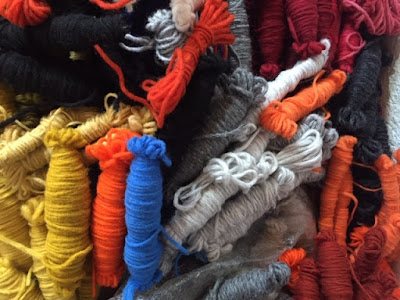 Throughout this Blog, I've often highlighted different types of artistry found in Ecuador. In today's post, I'd like to dig a little deeper into the talented artists who make their living in my Province of Imbabura. Their traditions and artistry are nationally recognized and interwoven into every part of Ecuadorian culture.
Throughout this Blog, I've often highlighted different types of artistry found in Ecuador. In today's post, I'd like to dig a little deeper into the talented artists who make their living in my Province of Imbabura. Their traditions and artistry are nationally recognized and interwoven into every part of Ecuadorian culture. When tourists think of Ecuadorian and Andean art, it's usually the colorful ponchos, tapestries and needlework that come to mind. Up and down the spine of the Andes, people have been using alpaca and sheep wool for centuries to weave beautiful blankets and sweaters, while embroidering delicate
When tourists think of Ecuadorian and Andean art, it's usually the colorful ponchos, tapestries and needlework that come to mind. Up and down the spine of the Andes, people have been using alpaca and sheep wool for centuries to weave beautiful blankets and sweaters, while embroidering delicatelinens and blouses.
The Otavalo Market is Ecuador's showcase for these beautiful textiles, and luckily it's only about 30 minutes from Ibarra.
I take all my visitors there and always find something new
I just have to have for myself.
On Saturdays, the Otavalo Market also features other local artists such as
jewelry makers, woodworkers, metalsmiths, and painters. Painting is
a time honored and revered tradition here in Ecuador.
a time honored and revered tradition here in Ecuador.
 |
Many small pueblos around Imbabura are known for the exquisite needlework
of the Indigenous women. I see them sewing in their lap wherever I go...
on the bus, and on street corners while waiting for the bus.
When my sister Julie, and her husband Doug, came to visit, we took a private art tour
visiting workshops and artisan studios around Imbabura.


On our tour, we met a family of instrument makers who carved wind and string instruments. They also gave lessons in their home. Music fills every corner of Ecuador and is always floating on the air from somewhere. It was interesting to learn about the history of the
instruments that make up the heart of the traditional Andean sound.
Next, we visited a Tora Weaver. Tora is a tall grass that grows naturally and quickly
on the edge of the lakes. The people who live in the villages around Lago San Pablo
make money by cutting it, collecting it, drying it and weaving it into mats of all sizes.
 |
| This is Tora grass growing at the edge of our local lake. |


 |
| They also dye the reeds and weave them into baskets. It was so hard to decide which to buy! |
Then, we visited a jewelry designer who showed off her wares in her home. 
|
 |
 |
 |
| Afterwards, he demonstrated a traditional weaving method called back-strap weaving. To finish his work, he rubbed a thistle across the rug he wove to make the alpaca soft and smooth. |
 |
| Some weaving is still done in a traditional way, but behind a small door in his workshop was also a more modern method - a large loom. |

The last stop on our tour took us to the workshop of a well-known local weaver named Jose Cotacachi in the pueblo of Peguche. He started our tour by teaching us about how natural plants, animals and vegetables are used to naturally dye the wool.

To create the colors, he starts with the shells or eggs of a small insect found around the Andes (Dactylopius coccus). These mashed insects, a relative of the aphid, make rich purple-reds and pinks.

He added the juice of a lemon and it turned into orange.
Next, he added copper or iron oxide to get a purple. He continued his demonstration creating a variety of colors. Boiling nuts and seeds with the wool will turn it brown. Specific leaves and flowers from the mountains and rainforest can make a variety of greens, blues, grays and yellows. Black and whites are already the natural colors of the fleece from sheep and alpacas.
 |
| The colors of his wool were rich, vibrant and ready to weave! |
 |
| Jose used his floor loom to demonstrate a traditional method for weaving his beautiful tapestries. |
 |
| In the end, we were able to walk through all the rooms of his studio and dream about owning one for our own home. |
And as I said before, music infiltrates every fiber of life here in Ecuador... traditional Ecuadorian music, modern Rigatone, or Classic Rock and Roll from the US. It doesn't matter. Music steams from cars, pounds your ears in buses, and blares from houses and church loudspeakers. Every festival brings amateur musicians into the streets and weekly, there are free music concerts in the park. Here is a video of me and my Ecuadorian family enjoying a concert of Paulina Tamayo,
a famous well-known and well-loved Ecuadorian singer
who gets everyone in the crowd singing traditional favorites.
a famous well-known and well-loved Ecuadorian singer
who gets everyone in the crowd singing traditional favorites.
If you can't see the videos, go to onthewingadventures.blogspot.com
And I'll close with an excerpt from an Indigenous band who, for me, exemplifies how
the beloved Ecuadorian traditional music is being transformed and reimagined
in modern ways. Ecuadorians applaud all artists who celebrate the old,
recreate new, or combine the two in interesting ways.
the beloved Ecuadorian traditional music is being transformed and reimagined
in modern ways. Ecuadorians applaud all artists who celebrate the old,
recreate new, or combine the two in interesting ways.
All of it is art, and all of it is important in Ecuador.




















No comments:
Post a Comment